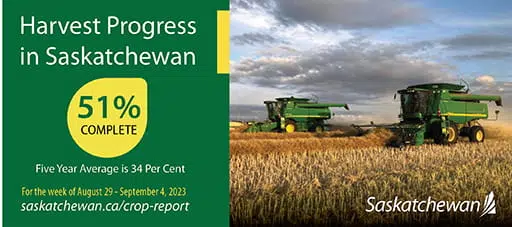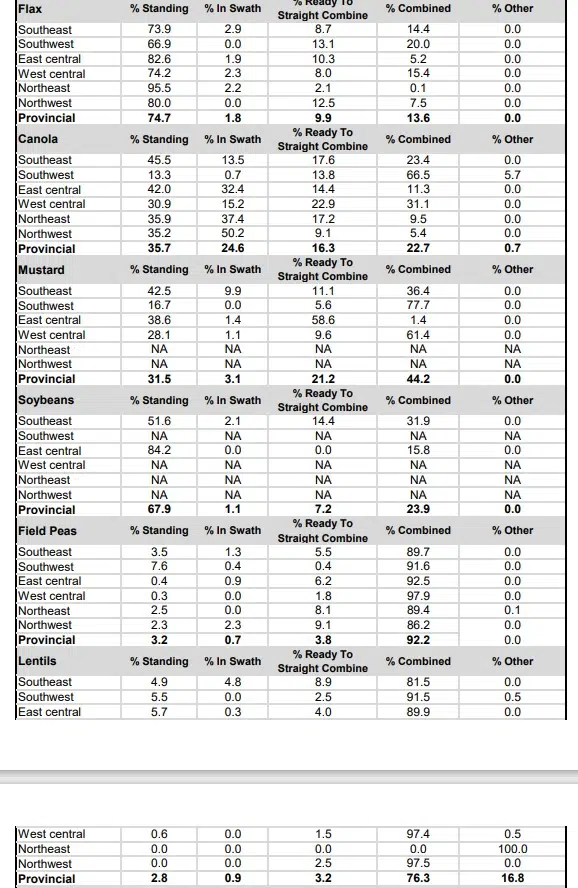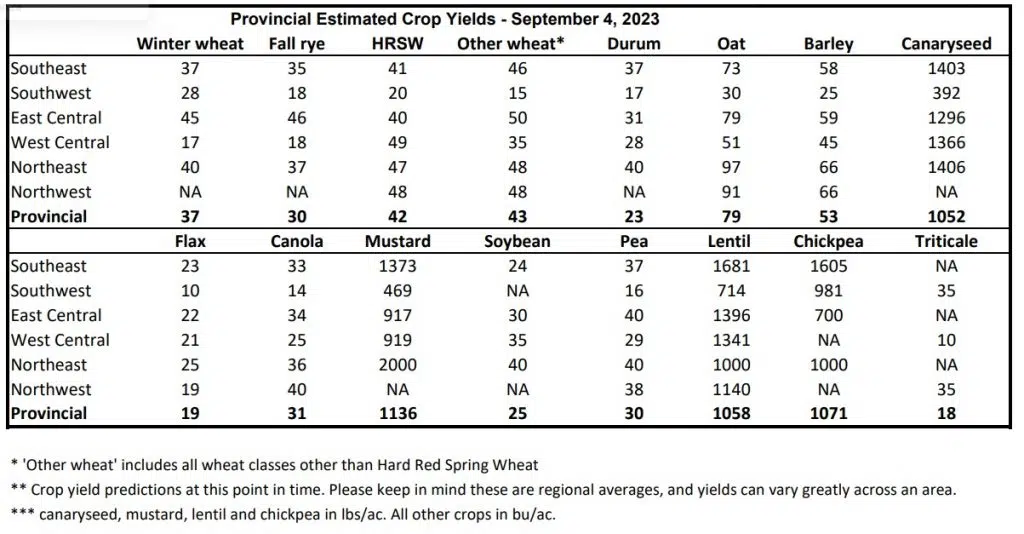
Saskatchewan Agriculture reports 51 per cent of the provincial crop had been combined as of Monday—well ahead of the five-year and ten-year averages and up from the 33 per cent in the previous crop report.
Eighty-one per cent has been combined in the southwest, followed by west central (60 per cent), southeast (49 per cent), east-central (34 per cent), northeast (32 per cent) and northwest (21 per cent).

 Volunteer crop reporters were asked to assess average yields for the various crops. There is plenty of variability depending on rainfall during the growing season.
Volunteer crop reporters were asked to assess average yields for the various crops. There is plenty of variability depending on rainfall during the growing season.

There was a slight improvement in topsoil moisture conditions following showers mainly over eastern regions of the province last week.



SOUTHEAST
Crop District 1 – Carnduff, Estevan, Redvers, Moosomin and Kipling areas;
Crop District 2 – Weyburn, Milestone, Moose Jaw, Regina and Qu’Appelle areas;
Crop District 3ASE – Radville, Minton and Lake Alma areas
The southeast is on the cusp of crossing the harvest halfway point this week, with 49 per cent of the crop combined so far, just ahead of the five-year average of 48 per cent. Moisture in the area paused combines for a few days; however, producers made great progress when conditions were favourable.
While producers have just a few acres of winter cereals left, spring cereals continue to be the main focus of many harvest operations. All spring cereals are over halfway harvested, with barley leading at 74 per cent complete for the year. Lentils and field peas are also close to being done, with less than 10 per cent of the crop still in the field. Chickpeas are 48 per cent in the bin for the year. Mustard continues to lead the oilseeds with 36 per cent harvested, ahead of canola at 23 per cent and flax at 14 per cent.
Yield estimates are now being reported for the year. Spring rains and growing season moisture benefited the region. Hard Red Spring Wheat yields are estimated at 41 bu./ac., while canola is estimated at 33 bu./ac. Lentils are estimated to yield 1681 lbs./ac., and chickpeas are estimated to yield 1,605 lbs./ac.
The southeast received the most rain overall this past week, with all cropping districts in the region receiving rain. The Corning area received the most in the region, with 41 mm being reported. Cropland moisture is 36 per cent adequate, 36 per cent short and 28 per cent very short. Hay and pasture moisture is 30 per cent adequate, 42 per cent short and 28 per cent very short.
Crop damage in the area is due to grasshoppers, localized flooding, and sooty mold on standing crops. Producers are busy swathing, combining, and cleaning bins. Livestock producers are hauling water and feed while also preparing for the winter.
SOUTHWEST
Crop District 3ASW – Coronach, Assiniboia and Ogema areas;
Crop District 3AN – Gravelbourg, Mossbank, Mortlach and Central Butte areas;
Crop District 3B – Kyle, Swift Current, Shaunavon and Ponteix areas;
Crop District 4 – Consul, Maple Creek and Leader areas
Another warm and dry week allowed harvest to progress markedly in the southwest. The region is now 81 per cent completed harvest, ahead of the five-year average of 64 per cent. While some crops are still standing, a few operations were able to finish their last fields.
With winter cereals harvest completed and all spring cereals being 80 per cent or more harvested, producers are focusing on their oilseeds. Flax is 20 per cent harvested, while canola is 72 per cent harvested and mustard is 78 per cent in the bin. Lentils and peas are over 90 per cent harvested, and chickpeas are 54 per cent harvested for the year.
Regional yields for the southwest are well below those of the provincial averages due to dry conditions. Hard Red Spring Wheat is anticipated to yield 20 bu./ac., durum 17 bu./ac. and barley 25 bu./ac. Canola yields are estimated at 14 bu./ac., while mustard is 469 lbs./ac. Lentils are anticipated to be 714 lbs./ac. and chickpeas 981 lbs./ac.
Little moisture was received in the southwest this week, with Limerick reporting the most received with 17 mm. Topsoil moisture remains limited; 11 per cent of cropland moisture is adequate, 46 per cent is short and 43 per cent is very short. Hay and pasture moisture is even more limited, with only 10 adequate moisture, 30 per cent short and 60 per cent very short.
Crop damage this past week is due to grasshoppers and dry conditions. Sooty moulds have been threatening grades where moisture was received. Producers are busy wrapping up harvest, securing winter feed resources and hauling water for livestock.
WEST CENTRAL
Crop Districts 6B – Hanley, Outlook, Loreburn, Saskatoon and Arelee areas;
Crop District 7A – Rosetown, Kindersley, Eston, Major;
Crop District 7B – Kerrobert, Macklin, Wilkie and Biggar areas
The west central region continues to push through this year’s harvest, and it is now 60 per cent completed. This is ahead of the five-year average of 41 per cent.
With winter cereals, peas and lentils harvested for the year, producers are focusing on completing their spring cereals before moving their focus to oilseeds. Durum harvest is at 71 per cent, barley is 69 per cent, spring wheat is 63 per cent and oats are 61 per cent in the bin for the year. Mustard is 61 per cent harvested for the year, ahead of canola at 31 per cent and flax 15 per cent complete.
With over half the crop off for the year, yields can be estimated. Hard Red Spring Wheat is estimated to yield 49 bu./ac., durum to yield 28 bu./ac. and canola 25 bu./ac. Barley is estimated to yield 45 bu./ac. and triticale 10 bu./ac. Mustard is estimated to yield 919 lbs./ac. and lentils 1,341 lbs./ac.
The Rosetown area received 30 mm of rain this past week, the most for the region. Topsoil moisture remains limited. Cropland topsoil moisture is rated as 15 per cent adequate, 49 per cent is short and 36 per cent is very short. Hay and pasture land is rated as seven per cent adequate, 41 per cent short and 52 per cent very short.
Crop damage this past week was due to some hail damage, drought conditions and grasshoppers. Producers are busy swathing and combining. Livestock producers are also moving cattle, securing winter feed supplies, and hauling water.
EAST CENTRAL
Crop District 5 – Melville, Yorkton, Cupar, Kamsack, Foam Lake, Preeceville and Kelvington areas;
Crop District 6A – Lumsden, Craik, Watrous and Clavet areas
Moisture continues to dampen harvest in the east-central region. Despite more moisture this past week, producers were able to make great progress and are now 34 per cent complete harvest, this is ahead of the five-year average of 27 per cent.
Producers have finished their winter cereal, pea and lentil harvest operations and are now focusing on their spring cereals. Sixty-one per cent of barley, 41 per cent of durum, 38 per cent of spring wheat and 18 per cent of oats have been harvested this year. The region is just beginning their oilseed harvest with 16 per cent of soybeans, 11 per cent of canola, five per cent of flax and one per cent of mustard harvested.
For yield estimates in the region, Hard Red Spring Wheat is anticipated to yield 40 bu./ac., oats 79 bu./ac. and barley 59 bu./ac. Canola is estimated to yield 34 bu/ac and mustard is estimated at 917 lbs./ac. Lentils are estimated to yield 1,396 lbs./ac. and chickpeas 700 lbs./ac.
The Kelliher region received the most moisture this week, with 44 mm of rain being reported. The topsoil moisture is slowly improving in the area, with 55 per cent of cropland being adequate, 35 per cent being rated as short and 10 per cent very short. Hay and pasture remain more limited in moisture, with 37 per cent having adequate moisture, 49 per cent short and 13 per cent very short.
Crop damage this past week is due to grasshoppers, localized flooding and sooty moulds developing on standing crops. Producers are busy combining and harvesting, while livestock producers are also preparing to bring cattle home for the winter.
NORTHEAST
Crop District 8 – Hudson Bay, Tisdale, Melfort, Carrot River, Humboldt, Kinistino, Cudworth and Aberdeen areas;
Crop District 9AE – Prince Albert, Choiceland and Paddockwood areas
Producers in the northeast have made great progress this week, with 32 per cent of the crop harvested for the year. This is ahead of the five-year average of 21 per cent.
With winter cereals harvested for the year, producers have entered their spring cereal fields. Sixty-eight per cent of barley, 40 per cent of spring wheat and 34 per cent of oats have been harvested. Oilseeds remain the least harvested this week, with 10 per cent of canola harvested for the year.
Hard Red Spring Wheat is anticipated to yield 47 bu./ac., oats 97 bu./ac. and barley 66 bu./ac. Canola is anticipated to yield 36 bu./ac., while mustard is estimated to yield 2,000 lbs./ac. Lentils are estimated to yield 1,000 lbs./ac. and field peas are estimated to be at 40 bu./ac.
The region received some moisture this week, with the Humboldt area receiving 36 mm of rain. Topsoil moisture in the region is no longer a limiting factor. One per cent of cropland has adequate topsoil moisture, 79 per cent is adequate, 18 per cent is short and two per cent is very short. Seventy-one per cent of hay and pasture land have adequate topsoil moisture, 47 per cent is short and 13 per cent is very short.
Crop damage this past week is mostly attributed to grasshoppers, light frosts and geese returning to the field on their flights south. Producers in the area are busy swathing and combining, while livestock producers are also moving cattle out of pastures and preparing for winter.

























